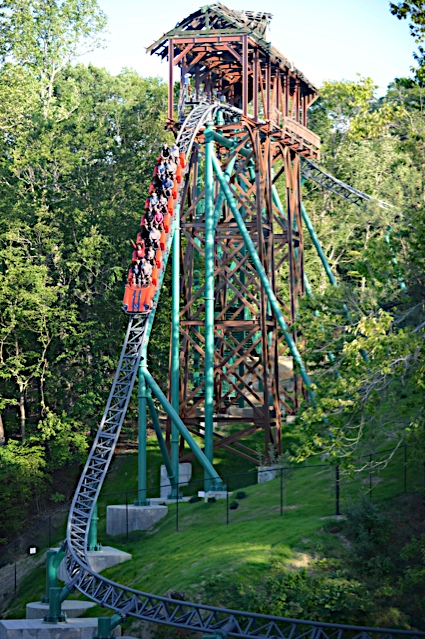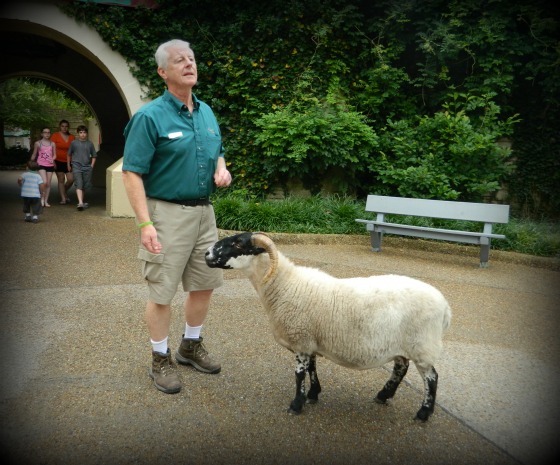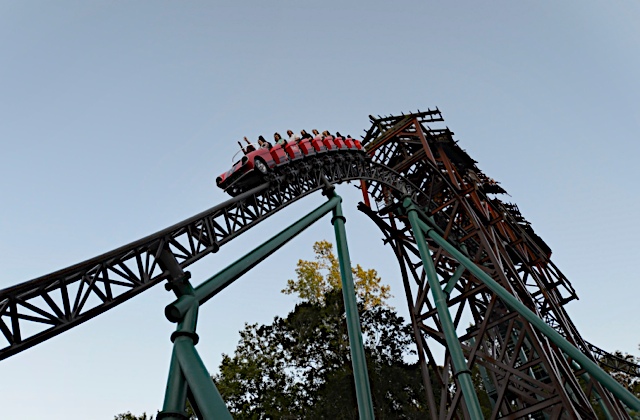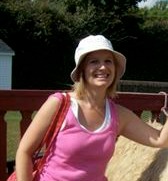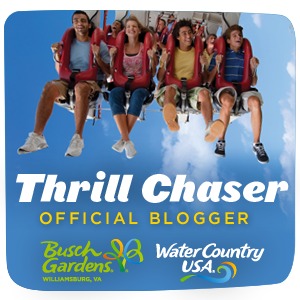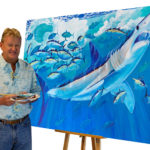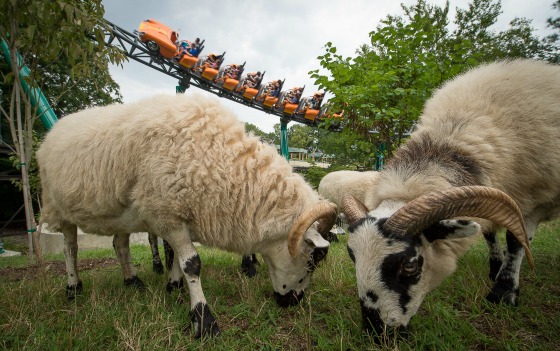
Scottish black-face sheep graze beneath Verbolten at Busch Gardens Williamsburg.
Photo: Busch Gardens
The world’s most beautiful park is going “baaaaaack” to the basics (pardon the puns, but there will probably be more) with its latest low-tech approach to landscaping. The park has added its flock of 17 Scottish black-face sheep to the gardening staff. This crew doesn’t care about perks, paychecks or pension plans. Usually seen at the Highland Stables in the Scotland village, these wooly workers can now be found grazing on the sloping hill beneath the tracks of Verbolten, the park’s newest hi-tech roller coaster.
The sheep have been trained to test an innovative and environmentally friendly program of “targeted grazing.” The initiative is a first for the park’s parent company, SeaWorld Parks & Entertainment, which cares for one of the largest collections of animals in the world across its 11 theme parks.
Targeted grazing involves training animals to naturally manage landscaping by eating grass and plants from certain areas. The innovative practice has had both environmental and operational benefits for Busch Gardens Williamsburg, including:
- Reducing the need for powered lawn equipment – thus reducing the park’s carbon footprint
- Saving nearly 100 gallons of fuel a year
- Saving nearly 288 labor hours a year, time that can be used for other landscaping initiatives (that require hands rather than hooves) such as flower pruning, edging and planting
- Producing manure for the turf
According to the press release put out by the park, the grazing program began earlier this summer and has been so successful that the park is now expanding and adding other animals, including a “clean-up crew” of chickens and turkeys.
In addition to their manual munching and green gardening methods, the sheep are a natural fit for the terrain in the park. Sheep are skilled and sure-footed on steep slopes that can sometimes present a problem to two-footed landscapers.
Implementing the targeted grazing program at Busch Gardens:
Step 1.) Preparing the landscape
The first step in implementing the new program involved carefully examining the plants on the ground beneath Verbolten’s steel track.
“Before launching the program, we extensively studied the toxicology of the plants in the park,’ said Jay Tacey, Busch Gardens’ zoological operations manager. “We scoured the area and removed any plants that might not be good for sheep,” said Tacey. “We haven’t had to remove much. The sheep graze on what they’re supposed to.”
Step 2.) Training the animals
Stephanie Peters, an animal care specialist at Busch Gardens, is one of several trainers who helped to acclimate the sheep to their new environment. This included using positive reinforcement techniques to desensitize the animals to the ambient roller coaster noise in the area.
“We took them out for an hour or two in the morning before the park opened when Verbolten was not running. After several positive tests, we brought the sheep out while the coaster was operating. When one of the coasters came around, we would give the sheep food and other forms of positive reinforcement as the coaster train passed over them,” said Peters. “If the sheep ignored the ride or moved close to a trainer instead of running away, we positively reinforced this behavior.”
The sheep quickly acclimated to the roller coasters. In fact, the total acclimation only took two days. It takes me longer than that to figure out a new phone.
Step 3.) Scheduling the crew
Once the sheep were comfortable, the zoological and landscaping staff worked together to determine how many animals were needed in the area. They also determined the grazing frequency and duration that the sheep needed to trim the grass down to the desired level. On average, the sheep graze for about five hours a day as part of the targeted grazing program, though the amount of time depends on the weather. The sheep are not brought out to graze during unfavorable weather conditions.
Step 4.) Expanding the program
In addition to sheep, Busch Gardens is training an avian “clean-up crew” consisting of two turkeys and four chickens. The birds will be released behind the sheep to eat ticks and other parasites while spreading the manure produced by the sheep.
“The chickens and turkeys are still young so they’re in the barn getting used to the sheep, hearing the music in the park and undergoing training sessions,” said Peters. “They’re being trained to recall to the trainer with a cowbell and also to enter an animal carrier when called. Eventually, we will deploy them under the roller coaster and let them do their thing.”
Who knew a chicken could be trained?
If you don’t believe sheep can be trained, take a look at this obedient fellow.
Facts about sheep
- Sheep, on average, graze about seven hours a day.
- A sheep eats about 2.5 to 3 pounds of grass a day.
- While grazing, sheep typically eat grass, clover and broad-leaf flowering plants called forbs.
Going Green with SeaWorld
Busch Gardens and SeaWorld Parks are strong supporters of conservation and promotion of the great outdoors. Earlier in the year, Busch Gardens held a Mom and Me Meetup with Mom Central founder Stacy DeBroff. This fun and kid-friendly gathering was all about getting outside and having “natural fun.” Read all about it right here.
Other natural and green initiatives by SeaWorld Parks & Entertainment include the decision to stop using plastic bags in the parks, making SeaWorld Parks the largest theme park operator to make this commitment. The park has also embraced the concept of reducing, reusing and recycling with their “cup that cares” reusable souvenir cup.
The SeaWorld Parks and Busch Gardens Conservation Fund
With a strong commitment to its “animal ambassadors,” SeaWorld Parks and Entertainment created the SeaWorld and Busch Gardens Conservation Fund to protect wildlife, support habitat conservation and provide research, education and animal rescue programs. The company cares for more than 60,000 animals, including 200 endangered or threatened species, and has rescued more than 20,000 orphaned, injured or ill animals over four decades.
SeaWorld’s commitment extends to animals around the world. The company has contributed more than $50 million to conservation, wildlife rescue and environmental stewardship initiatives and operates one of the world’s most respected animal rescue and rehabilitation programs. To learn more about this private, non-profit foundation, please visit www.SWBG-ConservationFund.org.
If you go
If you plan on attending the park this fall, please click here to find discount coupons, offers and in-park deals for the fall season at Busch Gardens Williamsburg.
I can’t wait to attend Howl-O-Scream, the park’s annual Halloween fright fest, this weekend. I hope to catch a glimpse of the new landscaping crew. How about you? Have ewe seen these workers in action? Last pun, I promise.
